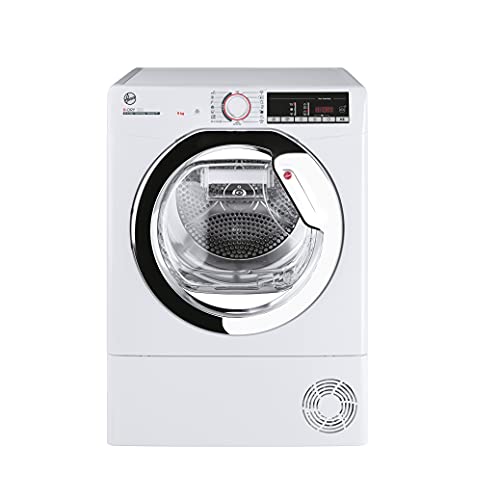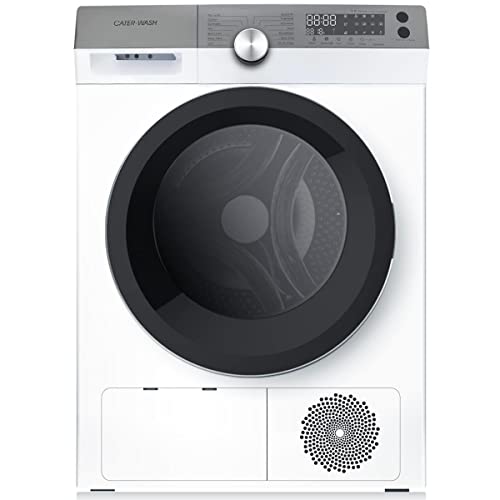근접센서 What Is The Reason Washer Dryer Heat Pump Is The Best Choice For You?
페이지 정보

본문
Heat Pump Washer Dryer
Heat pump dryers use refrigerants as well as a compressor to transfer heat energy from hot air into cold air. Then, it condenses water from your clothes. They're generally about 28% more efficient than vented dryers.
They don't vent outside and are quieter than traditional vented machines. They are also suitable for apartments, where it's not feasible to drill holes in the walls for vents.
Energy Efficiency
The laundry industry is looking for ways to cut down on the amount of energy they use in their facilities. One option has been to replace washers and dryers with more efficient models, but another option is to make use of a heat pump washer dryer to save even more energy while doing loads of laundry.
In a heat-pump washer dryer, hot drier air is used to eliminate moisture from the clothing. The air is then moved to the dryer's evaporator which evaporates the water and cools it. The water vapor is then condensed into droplets, which are collected for drainage. This system uses a lot less energy than a dryer that is electric, which expels warm, moist air outside through the vent.
 Heat pump washer dryers use about 28 percent less energy than standard washer Dryer heat Pump dryers. This savings on energy can add up, particularly if the dryer is used regularly enough to pay for the initial investment.
Heat pump washer dryers use about 28 percent less energy than standard washer Dryer heat Pump dryers. This savings on energy can add up, particularly if the dryer is used regularly enough to pay for the initial investment.
The reason heat pump washer dryers are so energy efficient is that they don't require their own heat through gas burners or electric coils. They move thermal energy through an enclosed loop. They take and recycle the hot air that is trapped inside the drum. They then move it to the Evaporator, and then back to drum to repeat the procedure.
They are also more ecologically green than traditional dryers which take conditioned outdoor air and discharge it through the vent. The air used has already used up a lot of energy and money in the form air conditioning to cool it down or a furnace for heating the temperature inside the building.
A hybrid heat pump washer dryer with sorption can achieve even better efficiency than an electric model. The process of sorption is labor intensive however it can be combined with heat pump technology to make a more efficient machine. Khouya and Cranston were the first to introduce this combination of heat pumps and sorption. They studied the effects of different parameters, including optical efficiency and concentration ratio on the performance of the system.
Condensation
Unlike conventional dryers that exhaust out the vent they circulate the heated air, making them much better for the environment and less expensive to run over the course of. It is important to know that recirculating hot air can cause condensation in the dryer, which can lead to mold and mildew problems.
The reason the condensation occurs is that the recirculated hot air will always lose some energy to internal losses. This is a slight way to make up for the heat lost due to evaporation. This causes a slight increase in the temperature of the recirculating air. As the hot air recirculates on the cold side, it absorbs the water vapour from wet clothes. It transforms into liquid water that drips into the lint tube or tray.
To avoid mildew and mold To avoid mold and mildew, empty the lint tube or tray once it's full. The trays must also be cleaned frequently. The majority of trays can be removed for cleaning. It's also important to keep the lint filter clean in the dryer which can prevent obstructions and condensation.
Another issue that could arise from the condensation caused by heat pumps dryers is that they may take longer to dry clothes than conventional dryers. The reason is that heat pump dryers operate at lower temperatures than conventional dryers, which could make it more difficult to get the clothes completely dry.
It's also possible that the condensation is caused by a ventilation system, which must be inspected for leakage. If the duct is damaged, it is likely to leak water and create the condensation problem. The duct for ventilation must be properly sealed in order to prevent water from leaking into the home. It's also important to ensure that the vent hose is in a proper position and to not let it hang too low, which could also lead to condensation. The duct for ventilation should be inspected for blockages due to debris and lint that can build up over time and cause venting issues.
Noise
The heat pump inside your dryer produces low humming sounds when it is running. This is normal and is the sound of a highly efficient system working as designed.
If you can hear your machine rattling or scraping, during your washing cycle, it is possible that your dryer is rattling up against a wall or an appliance. If this is the case, move your dryer a few feet away from any obstructions and this will stop the rattle. If you hear a rattling sound coming from your dryer, it could be a sign of loose parts or a blocked airflow.
Overloading your Miele dryer with clothes can cause it to rattle. This could cause the dryer to work harder to rotate. Try to take off some of the clothing to ease the load.
The drum bearings may cause an erupting. They are prone to wear out and make noise over time. Examine to determine if the bearings are in good working order. If they are not, you may be able to have an expert replace them.
The baffles of your dryer may cause a rattling sound during drying. They are a great way to prevent your clothes from clumping together and aid in the tumbling and fusing of your clothing. If your baffles are worn or have loose change, they could be pushed against the drum's side and cause a clumping thumping noise. Check the baffles to see whether any items are heat pump tumble dryers any good stuck, and clean them as necessary.
If the noise is coming from the blower wheel, it is an indication that it's in a state of disarray or is off-balance. The wheel circulates air through the dryer and out of the exhaust vent. If it's blocked by lint, it can make an eerie sound.
If your Miele dryer continues to make grinding and loud rattling sounds after you've tried all of these ways to fix the problem, it could be a defective component. It's likely to require the removal of the cabinet and dryer drum to determine what's causing the issue It is recommended to call an appliance repair expert for assistance.
 Maintenance
Maintenance
A few simple maintenance tips can prevent many dryer and washer issues. For instance, cleaning regularly the lint trap and the slot can save money on energy costs and also reduce drying time. It is also important to keep up with the manufacturer's recommendations regarding the condenser coils.
In addition to a standard lint trap, heat pump dryers have an additional filter to protect the delicate coils from the lint contained in recirculated air. The filter needs to be cleaned after every few cycles using a cloth and vinegar or dish soap. Maintenance of the moisture sensor is crucial. The moisture sensor is located in the door, and washer dryer heat pump is used to determine the moment when a load has reached an appropriate degree of dryness. It is important to clean the sensor every now and then using a soft cloth and a little mild dish soap or water.
If your dryer is taking longer than usual to complete an entire cycle, it might be required to clean the heat exchanger. This is a straightforward process to do every month. Remove the drain hose (A) first. Mix neutral detergent with lukewarm lukewarm and place the other end of the accessory tube in the hole (B). Finally, insert the other end of the hose into the hole (A). Let the mixture sit for 30 minutes, then wash it off and dry it.
Heat pump dryers use refrigerants as well as a compressor to transfer heat energy from hot air into cold air. Then, it condenses water from your clothes. They're generally about 28% more efficient than vented dryers.
They don't vent outside and are quieter than traditional vented machines. They are also suitable for apartments, where it's not feasible to drill holes in the walls for vents.
Energy Efficiency
The laundry industry is looking for ways to cut down on the amount of energy they use in their facilities. One option has been to replace washers and dryers with more efficient models, but another option is to make use of a heat pump washer dryer to save even more energy while doing loads of laundry.
In a heat-pump washer dryer, hot drier air is used to eliminate moisture from the clothing. The air is then moved to the dryer's evaporator which evaporates the water and cools it. The water vapor is then condensed into droplets, which are collected for drainage. This system uses a lot less energy than a dryer that is electric, which expels warm, moist air outside through the vent.
 Heat pump washer dryers use about 28 percent less energy than standard washer Dryer heat Pump dryers. This savings on energy can add up, particularly if the dryer is used regularly enough to pay for the initial investment.
Heat pump washer dryers use about 28 percent less energy than standard washer Dryer heat Pump dryers. This savings on energy can add up, particularly if the dryer is used regularly enough to pay for the initial investment.The reason heat pump washer dryers are so energy efficient is that they don't require their own heat through gas burners or electric coils. They move thermal energy through an enclosed loop. They take and recycle the hot air that is trapped inside the drum. They then move it to the Evaporator, and then back to drum to repeat the procedure.
They are also more ecologically green than traditional dryers which take conditioned outdoor air and discharge it through the vent. The air used has already used up a lot of energy and money in the form air conditioning to cool it down or a furnace for heating the temperature inside the building.
A hybrid heat pump washer dryer with sorption can achieve even better efficiency than an electric model. The process of sorption is labor intensive however it can be combined with heat pump technology to make a more efficient machine. Khouya and Cranston were the first to introduce this combination of heat pumps and sorption. They studied the effects of different parameters, including optical efficiency and concentration ratio on the performance of the system.
Condensation
Unlike conventional dryers that exhaust out the vent they circulate the heated air, making them much better for the environment and less expensive to run over the course of. It is important to know that recirculating hot air can cause condensation in the dryer, which can lead to mold and mildew problems.
The reason the condensation occurs is that the recirculated hot air will always lose some energy to internal losses. This is a slight way to make up for the heat lost due to evaporation. This causes a slight increase in the temperature of the recirculating air. As the hot air recirculates on the cold side, it absorbs the water vapour from wet clothes. It transforms into liquid water that drips into the lint tube or tray.
To avoid mildew and mold To avoid mold and mildew, empty the lint tube or tray once it's full. The trays must also be cleaned frequently. The majority of trays can be removed for cleaning. It's also important to keep the lint filter clean in the dryer which can prevent obstructions and condensation.
Another issue that could arise from the condensation caused by heat pumps dryers is that they may take longer to dry clothes than conventional dryers. The reason is that heat pump dryers operate at lower temperatures than conventional dryers, which could make it more difficult to get the clothes completely dry.
It's also possible that the condensation is caused by a ventilation system, which must be inspected for leakage. If the duct is damaged, it is likely to leak water and create the condensation problem. The duct for ventilation must be properly sealed in order to prevent water from leaking into the home. It's also important to ensure that the vent hose is in a proper position and to not let it hang too low, which could also lead to condensation. The duct for ventilation should be inspected for blockages due to debris and lint that can build up over time and cause venting issues.
Noise
The heat pump inside your dryer produces low humming sounds when it is running. This is normal and is the sound of a highly efficient system working as designed.
If you can hear your machine rattling or scraping, during your washing cycle, it is possible that your dryer is rattling up against a wall or an appliance. If this is the case, move your dryer a few feet away from any obstructions and this will stop the rattle. If you hear a rattling sound coming from your dryer, it could be a sign of loose parts or a blocked airflow.
Overloading your Miele dryer with clothes can cause it to rattle. This could cause the dryer to work harder to rotate. Try to take off some of the clothing to ease the load.
The drum bearings may cause an erupting. They are prone to wear out and make noise over time. Examine to determine if the bearings are in good working order. If they are not, you may be able to have an expert replace them.
The baffles of your dryer may cause a rattling sound during drying. They are a great way to prevent your clothes from clumping together and aid in the tumbling and fusing of your clothing. If your baffles are worn or have loose change, they could be pushed against the drum's side and cause a clumping thumping noise. Check the baffles to see whether any items are heat pump tumble dryers any good stuck, and clean them as necessary.
If the noise is coming from the blower wheel, it is an indication that it's in a state of disarray or is off-balance. The wheel circulates air through the dryer and out of the exhaust vent. If it's blocked by lint, it can make an eerie sound.
If your Miele dryer continues to make grinding and loud rattling sounds after you've tried all of these ways to fix the problem, it could be a defective component. It's likely to require the removal of the cabinet and dryer drum to determine what's causing the issue It is recommended to call an appliance repair expert for assistance.
 Maintenance
MaintenanceA few simple maintenance tips can prevent many dryer and washer issues. For instance, cleaning regularly the lint trap and the slot can save money on energy costs and also reduce drying time. It is also important to keep up with the manufacturer's recommendations regarding the condenser coils.
In addition to a standard lint trap, heat pump dryers have an additional filter to protect the delicate coils from the lint contained in recirculated air. The filter needs to be cleaned after every few cycles using a cloth and vinegar or dish soap. Maintenance of the moisture sensor is crucial. The moisture sensor is located in the door, and washer dryer heat pump is used to determine the moment when a load has reached an appropriate degree of dryness. It is important to clean the sensor every now and then using a soft cloth and a little mild dish soap or water.
If your dryer is taking longer than usual to complete an entire cycle, it might be required to clean the heat exchanger. This is a straightforward process to do every month. Remove the drain hose (A) first. Mix neutral detergent with lukewarm lukewarm and place the other end of the accessory tube in the hole (B). Finally, insert the other end of the hose into the hole (A). Let the mixture sit for 30 minutes, then wash it off and dry it.
- 이전글What To Focus On When The Improvement Of Washer And Dryer In One Machine 24.04.29
- 다음글5 Lessons You Can Learn From Mesothelioma Settlement 24.04.29
댓글목록
등록된 댓글이 없습니다.
